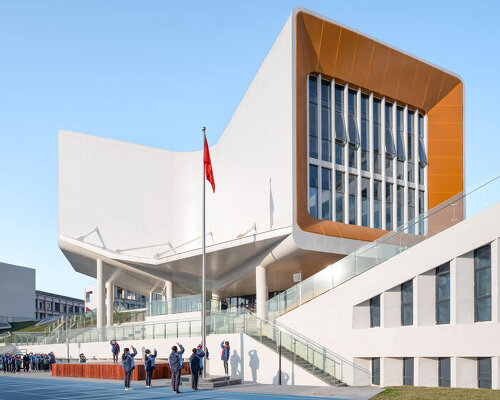LYCS architecture introduces open and adaptable school layout
LYCS Architecture designs the campus for Quzhou No.6 Experimental School, located on Changshan Road in Quzhou’s High-Speed Rail New Town. Quzhou No.6 Experimental School spans approximately 67,500 sqm and comprises facilities for a 36-class primary school and an 18-class middle school. The project addresses evolving educational needs by introducing an open and adaptable layout.
Traditional school campuses are typically composed of plazas, courtyards, and circulation roads with clearly defined boundaries. In contrast, the design of this campus seeks to accommodate the spatial demands of contemporary educational models, which emphasize interaction, exploration, and flexibility over static classroom instruction. The architectural response aims to create an environment that integrates various zones of activity and supports different modes of learning.
all images by LYCS Architecture
Quzhou No.6 Experimental School organizes layered spaces
The design team at LYCS Architecture organizes the campus along a west-to-east axis and employs a spatial concept referred to as the ‘Tree of Growth.’ In this framework, teaching spaces represent the roots, transitional or hybrid spaces form the trunk, and innovation spaces make up the canopy. This conceptual layering informs the distribution and function of built elements across the site. Public and semi-public spaces are distributed at multiple scales, including pocket parks near classrooms, alcoves at corridor ends, and larger shared facilities for cultural and athletic use. These zones are designed to correspond with different periods of the school day, supporting informal interactions, transitions between activities, and larger gatherings.
The project introduces a primary circulation route conceptualized as a ‘campus street,’ which serves as the main organizing spine. A winding main street running south to north connects key programmatic areas, educational, cultural, and communal. This path is supplemented by a network of secondary routes extending east to west, navigating changes in elevation and linking elements such as sunken gardens, semi-enclosed courtyards, and raised walkways. This circulation system not only facilitates movement but also introduces spatial variety along the way. Facades, vegetation, and structural elements are positioned to create shifting visual experiences. The layout promotes unplanned interactions and varied spatial encounters as part of the daily routine.
Quzhou No.6 Experimental School spans 67,500 sqm in Quzhou’s High-Speed Rail New Town
design composes interplay of solids and voids, color, and form
The academic zone comprises two ‘E’-shaped building clusters aligned along one side of the main street. These clusters feature articulated gable-end facades that incorporate staircases, rest platforms, and open-air entry points. The design uses contrasts of material solidity and void, color, and form to emphasize the importance of these edge conditions. Above the main circulation, ‘sky pocket parks’ offer informal outdoor learning environments on upper levels. These spaces vary in layout and design, supporting casual use and encouraging interaction. They contribute to a spatial rhythm across the teaching blocks: terminal space, internal corridor, and open rooftop park. The floor plates are staggered to create semi-open, transitional spaces where students can engage in activities such as discussion, informal performances, or small group work. These ‘grey zones’ are designed to serve as extensions of the classroom, allowing for diverse modes of use.
Opposite the academic zone, the Cultural and Sports Center consists of four distinct volumes positioned across a landscaped slope. These buildings vary in geometry and function, supporting a range of activities in a non-linear configuration. The design addresses the site’s elevation changes through terracing, integrating outdoor play and activity zones within the natural topography. A stepped plaza known as the ‘Grand Steps’ functions as a transitional space between the sports field and indoor cultural facilities. In addition to facilitating daily circulation and events such as flag-raising ceremonies, this area is designed to accommodate flexible use, including group reading, small performances, and informal exercise.
facilities accommodate a 36-class primary school and an 18-class middle school
Quzhou No.6 Experimental School reconsiders the spatial organization of educational environments by incorporating adaptable layouts and multipurpose zones. Through a layered system of teaching, hybrid, and innovation spaces, linked by a continuous circulation spine and distributed open areas, the design supports both structured education and spontaneous activity. The campus layout by LYCS Architecture reflects an architectural response to changing pedagogical requirements and introduces spatial strategies intended to accommodate flexibility, interaction, and ecological integration.
the design responds to evolving educational needs with adaptable spatial planning
campus layout shifts away from rigid boundaries toward interconnected learning zones
public spaces of varying scale support transitions between learning and leisure
classroom clusters are integrated with pocket parks and alcove seating areas
changing elevations and textures create diverse spatial encounters across the site
‘sky pocket parks’ introduce informal learning spaces at upper levels
the main circulation path, or ‘campus street’, links academic, cultural, and communal zones
two ‘E’-shaped teaching blocks define the academic core along the main street
floor plate staggering creates semi-open zones for discussion and activity
project info:
name: Quzhou No.6 Experimental School
architect: LYCS Architecture | @lycsarchitecture
location: Kecheng, Quzhou, China
area: 67,500 sqm
client: Quzhou West District Investment Co., Ltd
designboom has received this project from our DIY submissions feature, where we welcome our readers to submit their own work for publication. see more project submissions from our readers here.
edited by: christina vergopoulou | designboom
The post classrooms integrate pocket parks in quzhou no.6 experimental school by LYCS architecture appeared first on designboom | architecture & design magazine.

